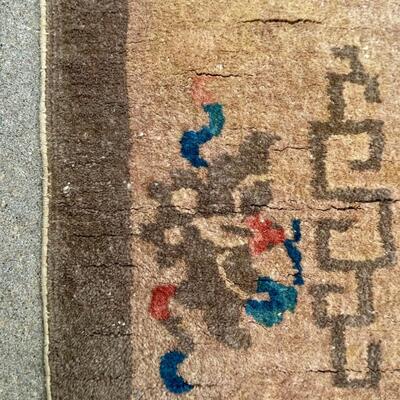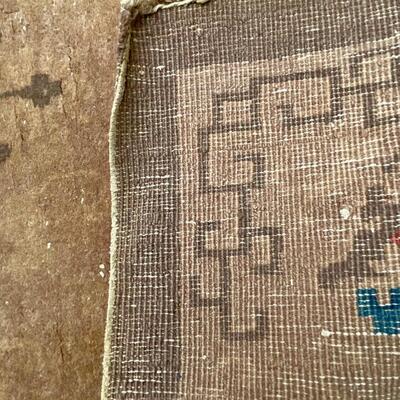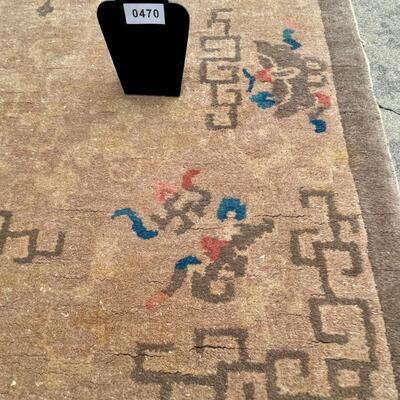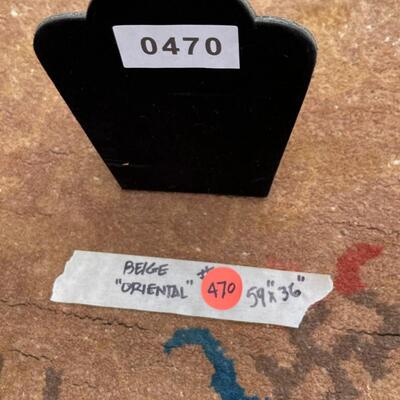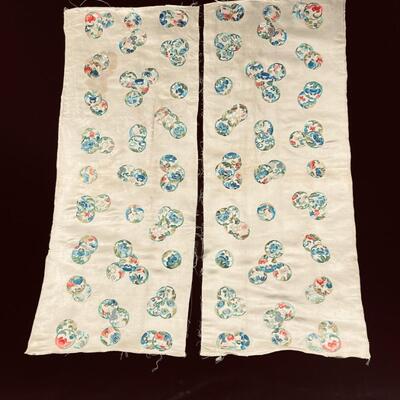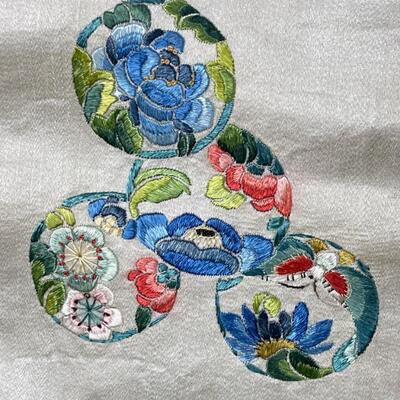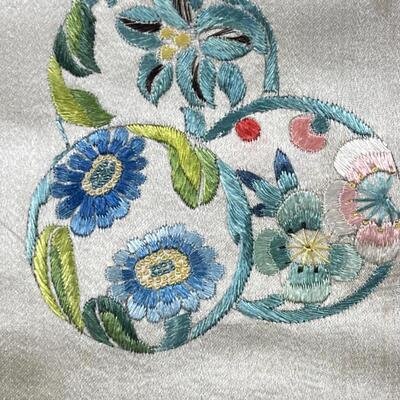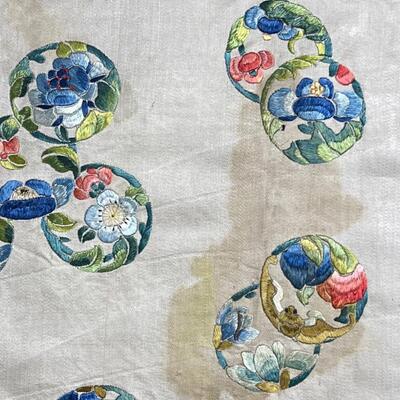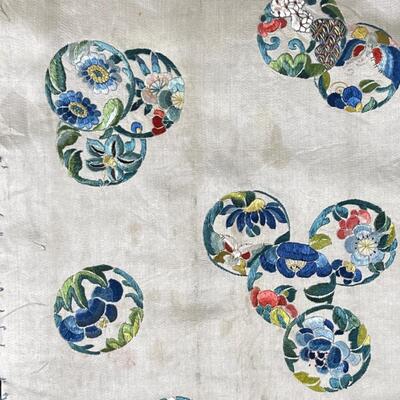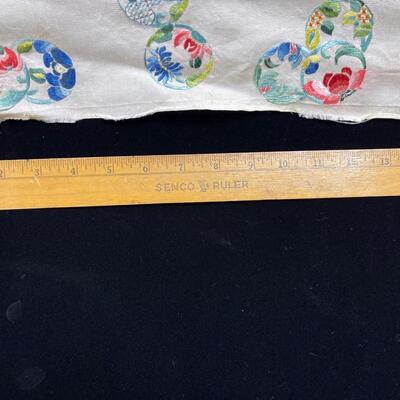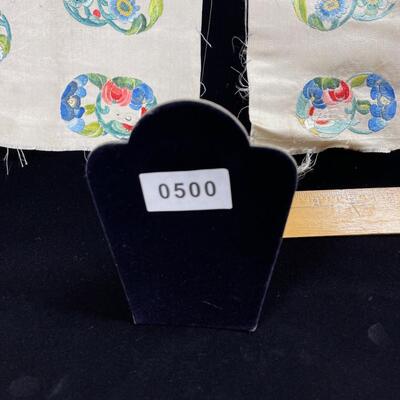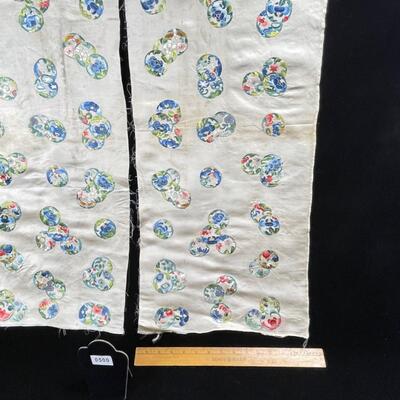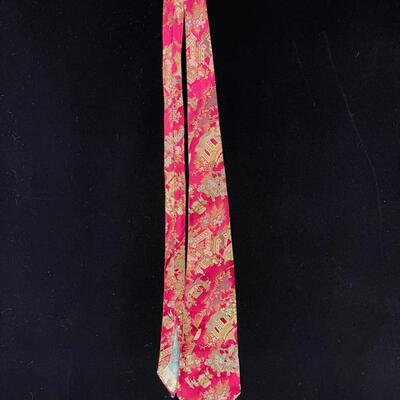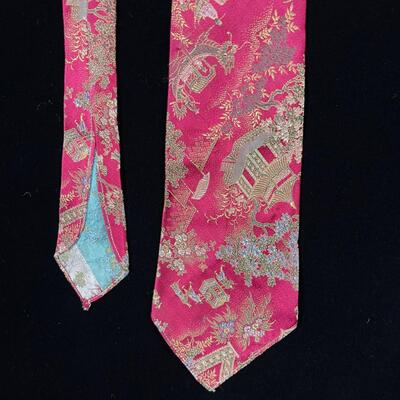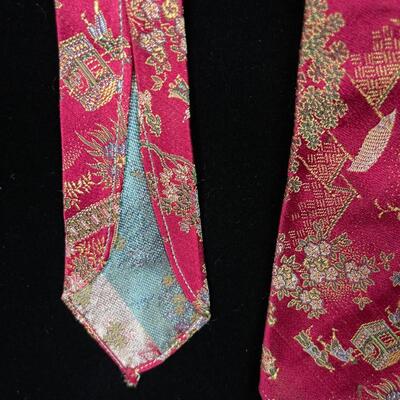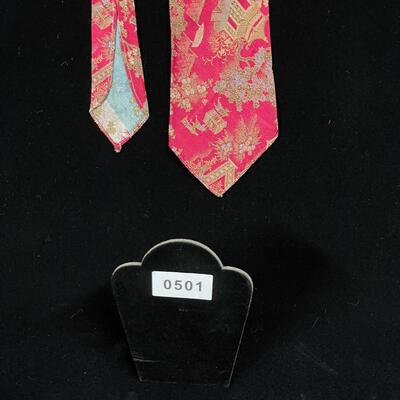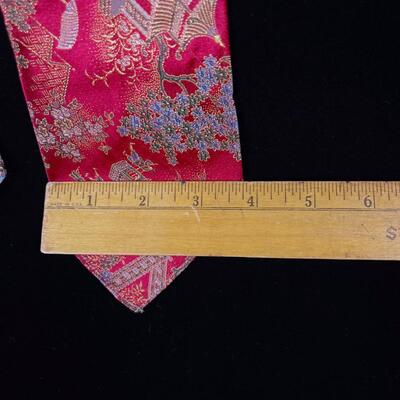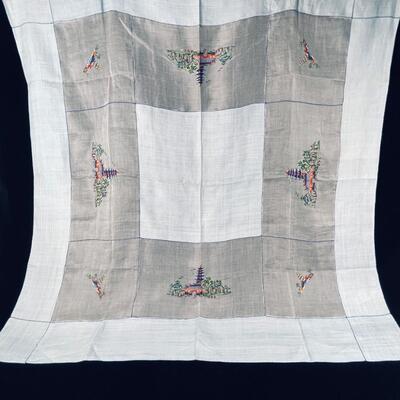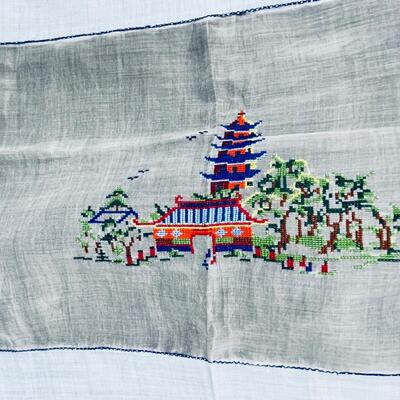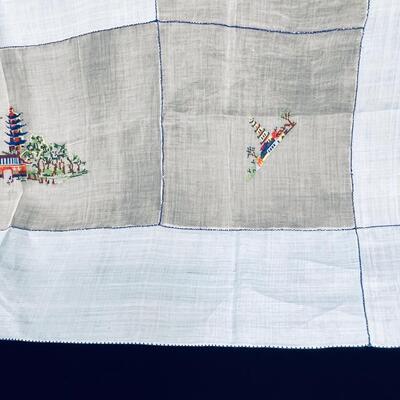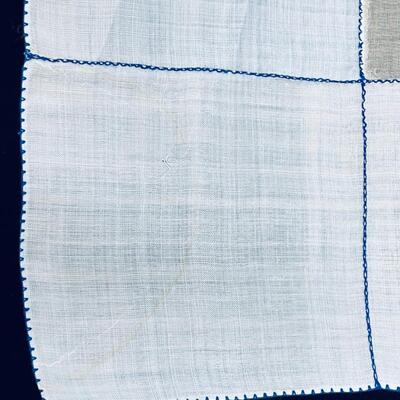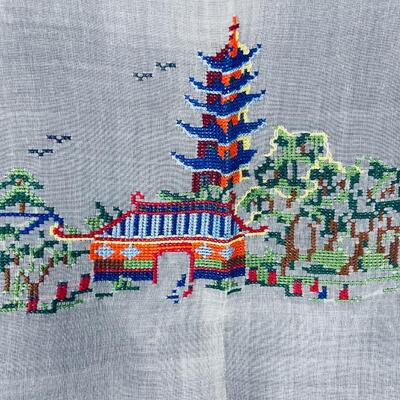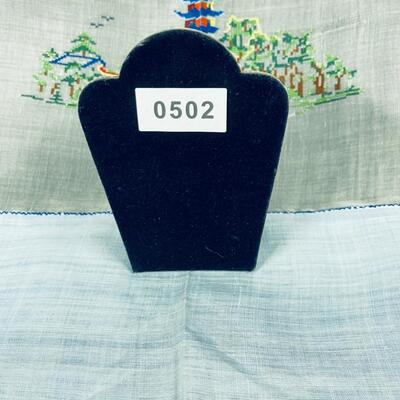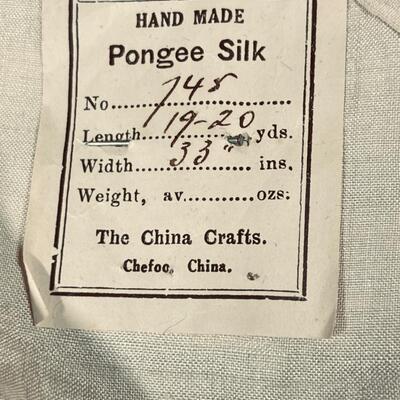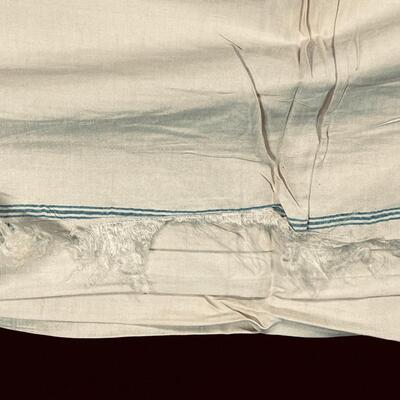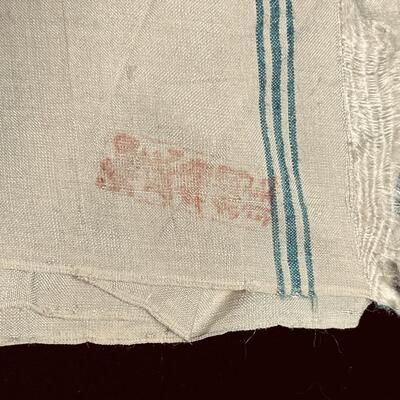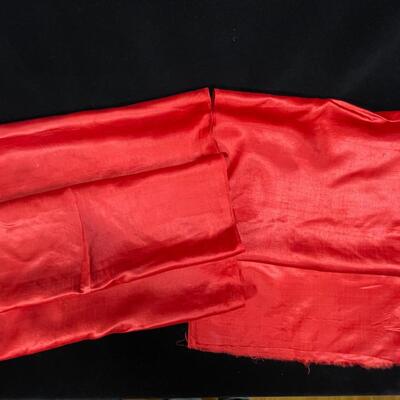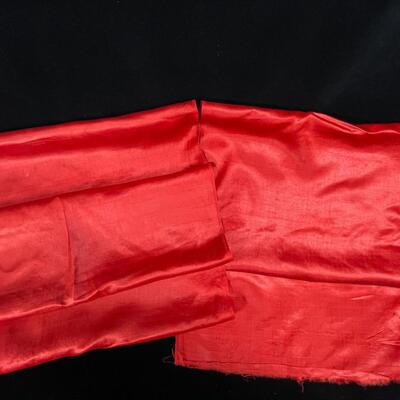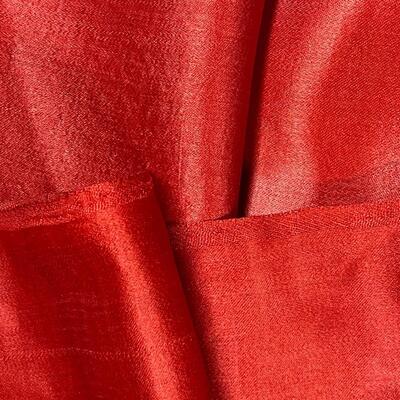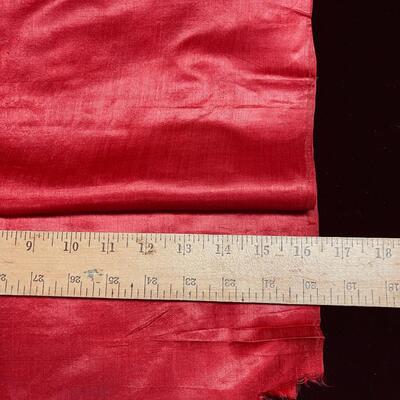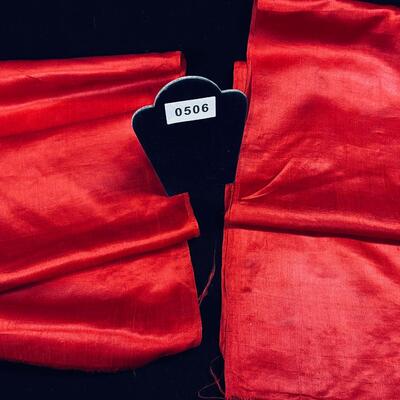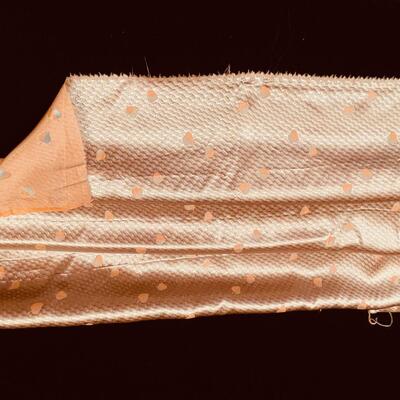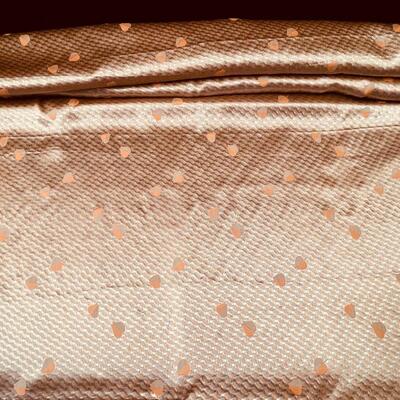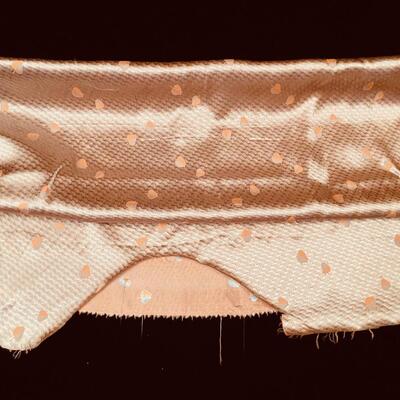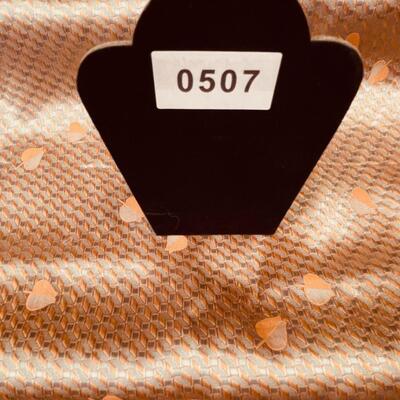-
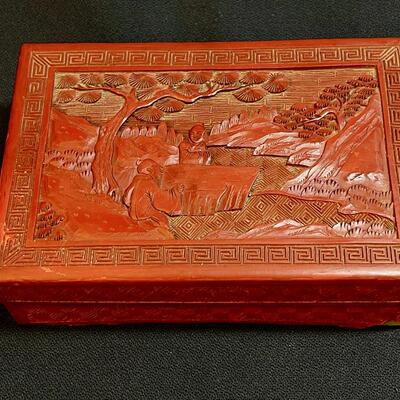
#473 ITEM: Red Carved Cinnabar Cigarette Box DESCRIPTION: This is a vintage carved red cinnabar cigarette box, traditionally carved with an oriental garden scene posing a teacher and student at study under a tree. Two of the corners exhibit some loss, and the expected wear of extended use and storage conditions. SIZE: 5.5 x 4.75 x 1.75 inches PRICE: $55. 805 / 1707 sold -
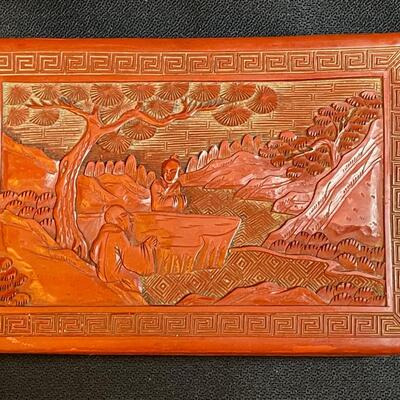
#473 ITEM: Red Carved Cinnabar Cigarette Box DESCRIPTION: This is a vintage carved red cinnabar cigarette box, traditionally carved with an oriental garden scene posing a teacher and student at study under a tree. Two of the corners exhibit some loss, and the expected wear of extended use and storage conditions. SIZE: 5.5 x 4.75 x 1.75 inches PRICE: $55. 806 / 1707 sold -
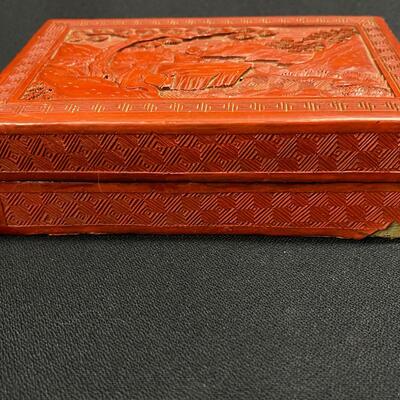
#473 ITEM: Red Carved Cinnabar Cigarette Box DESCRIPTION: This is a vintage carved red cinnabar cigarette box, traditionally carved with an oriental garden scene posing a teacher and student at study under a tree. Two of the corners exhibit some loss, and the expected wear of extended use and storage conditions. SIZE: 5.5 x 4.75 x 1.75 inches PRICE: $55. 807 / 1707 sold -
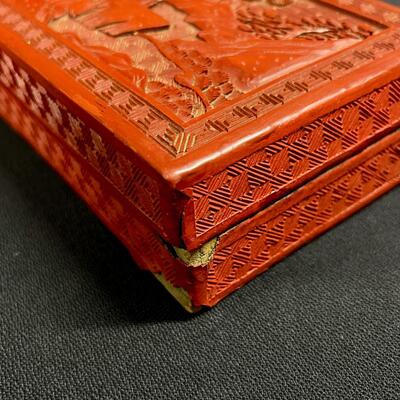
#473 ITEM: Red Carved Cinnabar Cigarette Box DESCRIPTION: This is a vintage carved red cinnabar cigarette box, traditionally carved with an oriental garden scene posing a teacher and student at study under a tree. Two of the corners exhibit some loss, and the expected wear of extended use and storage conditions. SIZE: 5.5 x 4.75 x 1.75 inches PRICE: $55. 808 / 1707 sold -
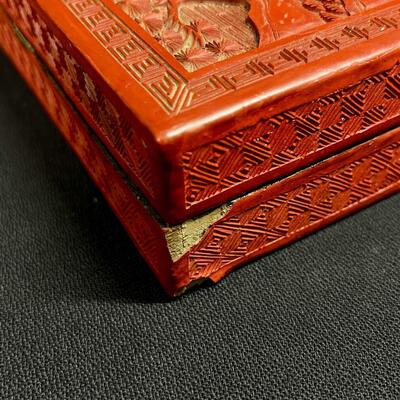
#473 ITEM: Red Carved Cinnabar Cigarette Box DESCRIPTION: This is a vintage carved red cinnabar cigarette box, traditionally carved with an oriental garden scene posing a teacher and student at study under a tree. Two of the corners exhibit some loss, and the expected wear of extended use and storage conditions. SIZE: 5.5 x 4.75 x 1.75 inches PRICE: $55. 809 / 1707 sold -

#473 ITEM: Red Carved Cinnabar Cigarette Box DESCRIPTION: This is a vintage carved red cinnabar cigarette box, traditionally carved with an oriental garden scene posing a teacher and student at study under a tree. Two of the corners exhibit some loss, and the expected wear of extended use and storage conditions. SIZE: 5.5 x 4.75 x 1.75 inches PRICE: $55. 810 / 1707 sold -

#473 ITEM: Red Carved Cinnabar Cigarette Box DESCRIPTION: This is a vintage carved red cinnabar cigarette box, traditionally carved with an oriental garden scene posing a teacher and student at study under a tree. Two of the corners exhibit some loss, and the expected wear of extended use and storage conditions. SIZE: 5.5 x 4.75 x 1.75 inches PRICE: $55. 811 / 1707 sold -
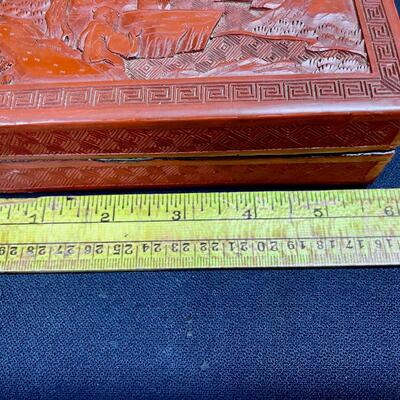
#473 ITEM: Red Carved Cinnabar Cigarette Box DESCRIPTION: This is a vintage carved red cinnabar cigarette box, traditionally carved with an oriental garden scene posing a teacher and student at study under a tree. Two of the corners exhibit some loss, and the expected wear of extended use and storage conditions. SIZE: 5.5 x 4.75 x 1.75 inches PRICE: $55. 812 / 1707 sold -
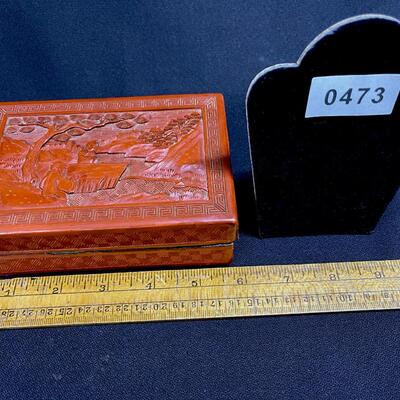
#473 ITEM: Red Carved Cinnabar Cigarette Box DESCRIPTION: This is a vintage carved red cinnabar cigarette box, traditionally carved with an oriental garden scene posing a teacher and student at study under a tree. Two of the corners exhibit some loss, and the expected wear of extended use and storage conditions. SIZE: 5.5 x 4.75 x 1.75 inches PRICE: $55. 813 / 1707 sold -
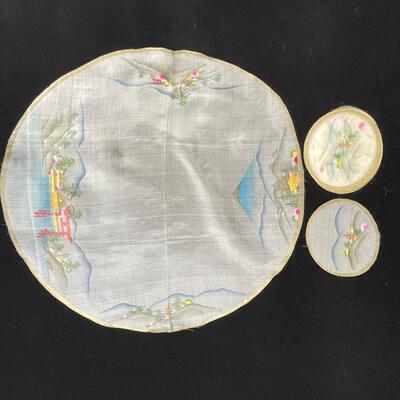
#500A ITEM: Vintage Japanese Tea Cloth DESCRIPTION: This lot is a Japanese sheer silk “tea cloth†made to dress the table for tea service in a private setting. The cloth has been painted with scenes of Mt. Fuji, and abstracted landscapes. Also included are 4 delicate coasters that are matching pieces. This set is absolutely charming! SIZE: Large D: 22 inches. Small D: 5.5 inches (the tablecloth does straighten out to a full, round circle - photo was a bit rushed. PRICE: $ 48. 822 / 1707 -
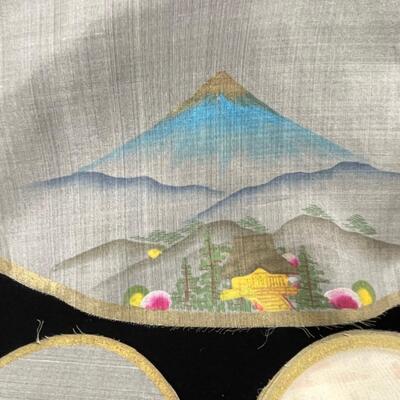
#500A ITEM: Vintage Japanese Tea Cloth DESCRIPTION: This lot is a Japanese sheer silk “tea cloth†made to dress the table for tea service in a private setting. The cloth has been painted with scenes of Mt. Fuji, and abstracted landscapes. Also included are 4 delicate coasters that are matching pieces. This set is absolutely charming! SIZE: Large D: 22 inches. Small D: 5.5 inches (the tablecloth does straighten out to a full, round circle - photo was a bit rushed. PRICE: $ 48. 823 / 1707 -
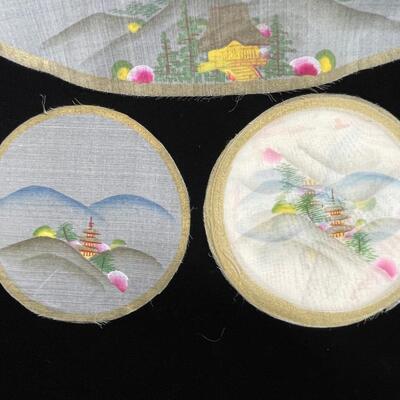
#500A ITEM: Vintage Japanese Tea Cloth DESCRIPTION: This lot is a Japanese sheer silk “tea cloth†made to dress the table for tea service in a private setting. The cloth has been painted with scenes of Mt. Fuji, and abstracted landscapes. Also included are 4 delicate coasters that are matching pieces. This set is absolutely charming! SIZE: Large D: 22 inches. Small D: 5.5 inches (the tablecloth does straighten out to a full, round circle - photo was a bit rushed. PRICE: $ 48. 824 / 1707 -
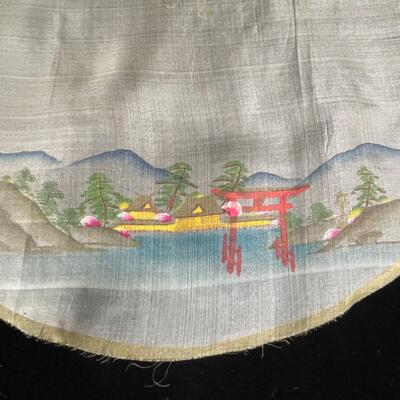
#500A ITEM: Vintage Japanese Tea Cloth DESCRIPTION: This lot is a Japanese sheer silk “tea cloth†made to dress the table for tea service in a private setting. The cloth has been painted with scenes of Mt. Fuji, and abstracted landscapes. Also included are 4 delicate coasters that are matching pieces. This set is absolutely charming! SIZE: Large D: 22 inches. Small D: 5.5 inches (the tablecloth does straighten out to a full, round circle - photo was a bit rushed. PRICE: $ 48. 825 / 1707 -
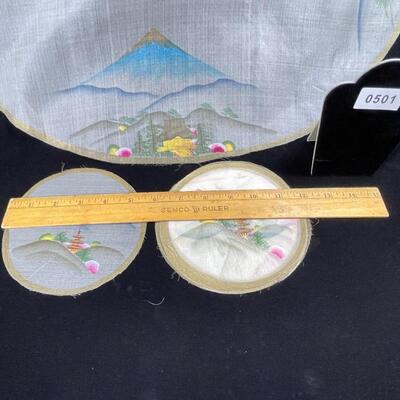
#500A ITEM: Vintage Japanese Tea Cloth DESCRIPTION: This lot is a Japanese sheer silk “tea cloth†made to dress the table for tea service in a private setting. The cloth has been painted with scenes of Mt. Fuji, and abstracted landscapes. Also included are 4 delicate coasters that are matching pieces. This set is absolutely charming! SIZE: Large D: 22 inches. Small D: 5.5 inches (the tablecloth does straighten out to a full, round circle - photo was a bit rushed. PRICE: $ 48. 826 / 1707 -
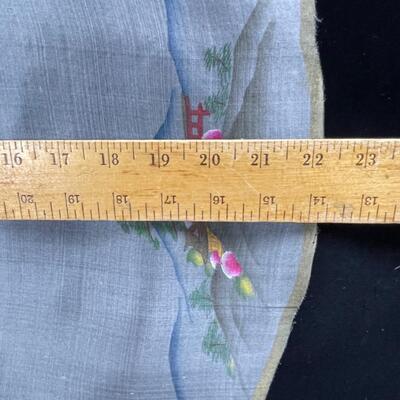
#500A ITEM: Vintage Japanese Tea Cloth DESCRIPTION: This lot is a Japanese sheer silk “tea cloth†made to dress the table for tea service in a private setting. The cloth has been painted with scenes of Mt. Fuji, and abstracted landscapes. Also included are 4 delicate coasters that are matching pieces. This set is absolutely charming! SIZE: Large D: 22 inches. Small D: 5.5 inches (the tablecloth does straighten out to a full, round circle - photo was a bit rushed. PRICE: $ 48. 827 / 1707 -
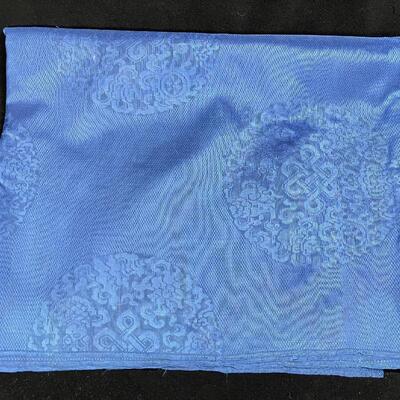
505 ITEM: Vintage Delicately patterned Blue Silk DESCRIPTION: This lot is a small yardage of delicately patterned blue silk woven with spaced roundels centered with the auspicious Chinese Knot symbol. Please note the hand under the fabric in several of the photos showing the sheer quality and pattern of this fabric. Condition is unused! SIZE: L: approximately W: 31 inches x L: 4 yards PRICE: $ 68. 845 / 1707 sold -
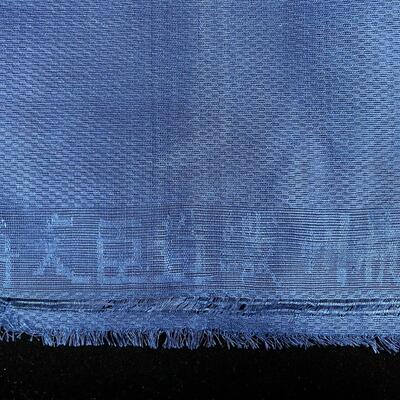
505 ITEM: Vintage Delicately patterned Blue Silk DESCRIPTION: This lot is a small yardage of delicately patterned blue silk woven with spaced roundels centered with the auspicious Chinese Knot symbol. Please note the hand under the fabric in several of the photos showing the sheer quality and pattern of this fabric. Condition is unused! SIZE: L: approximately W: 31 inches x L: 4 yards PRICE: $ 68. 846 / 1707 sold -

505 ITEM: Vintage Delicately patterned Blue Silk DESCRIPTION: This lot is a small yardage of delicately patterned blue silk woven with spaced roundels centered with the auspicious Chinese Knot symbol. Please note the hand under the fabric in several of the photos showing the sheer quality and pattern of this fabric. Condition is unused! SIZE: L: approximately W: 31 inches x L: 4 yards PRICE: $ 68. 847 / 1707 sold -
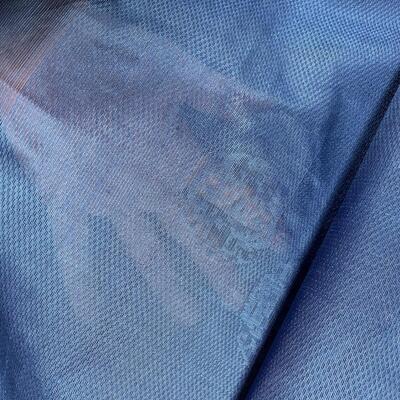
505 ITEM: Vintage Delicately patterned Blue Silk DESCRIPTION: This lot is a small yardage of delicately patterned blue silk woven with spaced roundels centered with the auspicious Chinese Knot symbol. Please note the hand under the fabric in several of the photos showing the sheer quality and pattern of this fabric. Condition is unused! SIZE: L: approximately W: 31 inches x L: 4 yards PRICE: $ 68. 848 / 1707 sold -
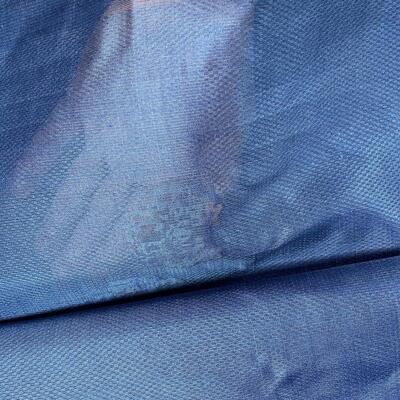
505 ITEM: Vintage Delicately patterned Blue Silk DESCRIPTION: This lot is a small yardage of delicately patterned blue silk woven with spaced roundels centered with the auspicious Chinese Knot symbol. Please note the hand under the fabric in several of the photos showing the sheer quality and pattern of this fabric. Condition is unused! SIZE: L: approximately W: 31 inches x L: 4 yards PRICE: $ 68. 849 / 1707 sold -

505 ITEM: Vintage Delicately patterned Blue Silk DESCRIPTION: This lot is a small yardage of delicately patterned blue silk woven with spaced roundels centered with the auspicious Chinese Knot symbol. Please note the hand under the fabric in several of the photos showing the sheer quality and pattern of this fabric. Condition is unused! SIZE: L: approximately W: 31 inches x L: 4 yards PRICE: $ 68. 850 / 1707 sold -
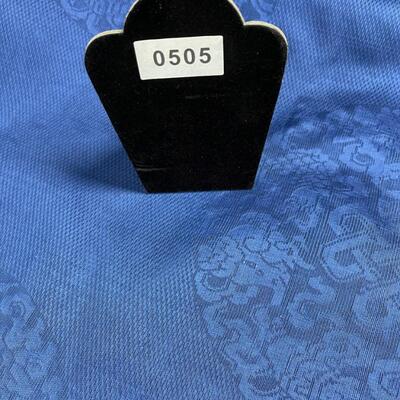
505 ITEM: Vintage Delicately patterned Blue Silk DESCRIPTION: This lot is a small yardage of delicately patterned blue silk woven with spaced roundels centered with the auspicious Chinese Knot symbol. Please note the hand under the fabric in several of the photos showing the sheer quality and pattern of this fabric. Condition is unused! SIZE: L: approximately W: 31 inches x L: 4 yards PRICE: $ 68. 851 / 1707 sold -
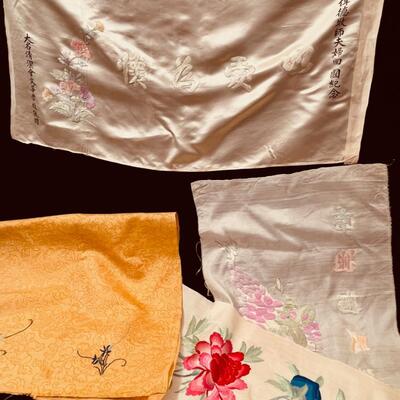
508 ITEM: A lot of 4 Vintage Embroidered Fragments DESCRIPTION: This lot is made up of 4 vintage silk fragments, all embroidered with floral patterns. One of the larger fragments also includes a vertical line of calligraphy that is most probably a poem. SIZE: Lengths are 29, 21, 31 and 28 inches PRICE: $ 32. 862 / 1707 sold -
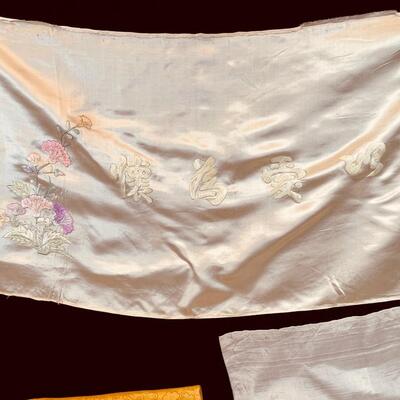
508 ITEM: A lot of 4 Vintage Embroidered Fragments DESCRIPTION: This lot is made up of 4 vintage silk fragments, all embroidered with floral patterns. One of the larger fragments also includes a vertical line of calligraphy that is most probably a poem. SIZE: Lengths are 29, 21, 31 and 28 inches PRICE: $ 32. 863 / 1707 sold -

508 ITEM: A lot of 4 Vintage Embroidered Fragments DESCRIPTION: This lot is made up of 4 vintage silk fragments, all embroidered with floral patterns. One of the larger fragments also includes a vertical line of calligraphy that is most probably a poem. SIZE: Lengths are 29, 21, 31 and 28 inches PRICE: $ 32. 864 / 1707 sold -
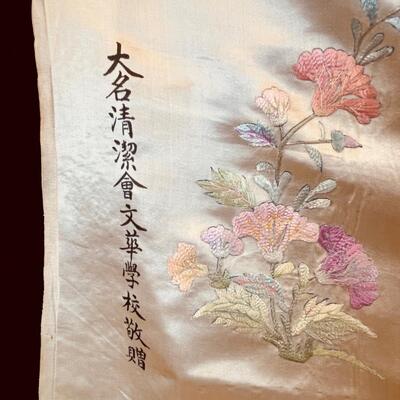
508 ITEM: A lot of 4 Vintage Embroidered Fragments DESCRIPTION: This lot is made up of 4 vintage silk fragments, all embroidered with floral patterns. One of the larger fragments also includes a vertical line of calligraphy that is most probably a poem. SIZE: Lengths are 29, 21, 31 and 28 inches PRICE: $ 32. 865 / 1707 sold -
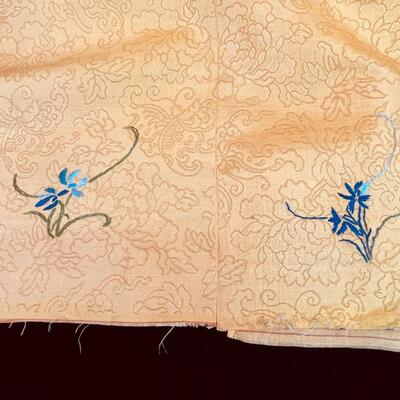
508 ITEM: A lot of 4 Vintage Embroidered Fragments DESCRIPTION: This lot is made up of 4 vintage silk fragments, all embroidered with floral patterns. One of the larger fragments also includes a vertical line of calligraphy that is most probably a poem. SIZE: Lengths are 29, 21, 31 and 28 inches PRICE: $ 32. 866 / 1707 sold -
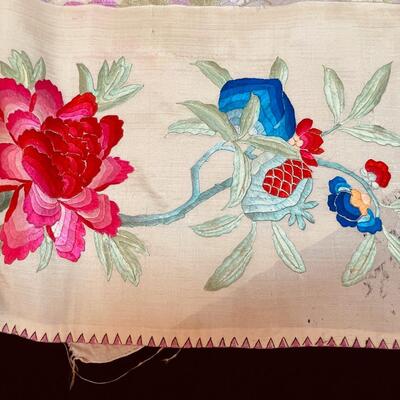
508 ITEM: A lot of 4 Vintage Embroidered Fragments DESCRIPTION: This lot is made up of 4 vintage silk fragments, all embroidered with floral patterns. One of the larger fragments also includes a vertical line of calligraphy that is most probably a poem. SIZE: Lengths are 29, 21, 31 and 28 inches PRICE: $ 32. 867 / 1707 sold -
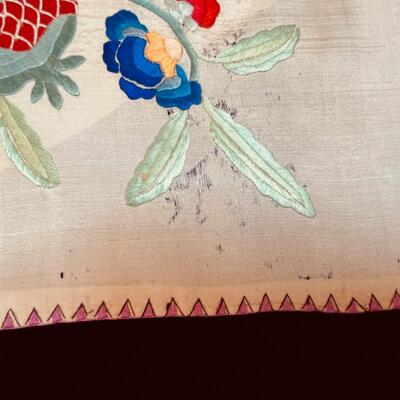
508 ITEM: A lot of 4 Vintage Embroidered Fragments DESCRIPTION: This lot is made up of 4 vintage silk fragments, all embroidered with floral patterns. One of the larger fragments also includes a vertical line of calligraphy that is most probably a poem. SIZE: Lengths are 29, 21, 31 and 28 inches PRICE: $ 32. 868 / 1707 sold -
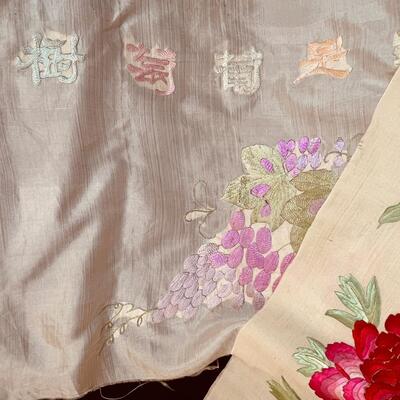
508 ITEM: A lot of 4 Vintage Embroidered Fragments DESCRIPTION: This lot is made up of 4 vintage silk fragments, all embroidered with floral patterns. One of the larger fragments also includes a vertical line of calligraphy that is most probably a poem. SIZE: Lengths are 29, 21, 31 and 28 inches PRICE: $ 32. 869 / 1707 sold -

508 ITEM: A lot of 4 Vintage Embroidered Fragments DESCRIPTION: This lot is made up of 4 vintage silk fragments, all embroidered with floral patterns. One of the larger fragments also includes a vertical line of calligraphy that is most probably a poem. SIZE: Lengths are 29, 21, 31 and 28 inches PRICE: $ 32. 870 / 1707 sold -

508 ITEM: A lot of 4 Vintage Embroidered Fragments DESCRIPTION: This lot is made up of 4 vintage silk fragments, all embroidered with floral patterns. One of the larger fragments also includes a vertical line of calligraphy that is most probably a poem. SIZE: Lengths are 29, 21, 31 and 28 inches PRICE: $ 32. 871 / 1707 sold -
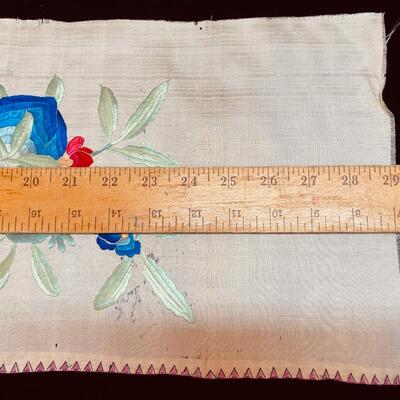
508 ITEM: A lot of 4 Vintage Embroidered Fragments DESCRIPTION: This lot is made up of 4 vintage silk fragments, all embroidered with floral patterns. One of the larger fragments also includes a vertical line of calligraphy that is most probably a poem. SIZE: Lengths are 29, 21, 31 and 28 inches PRICE: $ 32. 872 / 1707 sold -

#510 ITEM: Antique Chinese Hanging Calligraphic Scroll DESCRIPTION: The fine art of Chinese calligraphy/scroll painting has been a particularly venerated art in China for centuries, and often taught by Buddhist masters. This antique scroll displays a finely painted vertical, single-line arrangement of calligraphic characters that create an appropriate expression of blessing and good will, and has been traditionally mounted with a fabric support border laid down on heavy scroll paper. SIZE: 17 x 65.5 inches PRICE: $ 210. ---------- ABOUT: Chinese/Japanese Tea Ceremony Scroll. The Chinese Tea Ceremony scroll, often written by famous calligraphers, and later copied by buddhist monks, tea masters, or iemotos are traditionally hung in the tokonoma (alcove) of the tea room. The calligraphy scrolls may be writings of Chinese Zen priests or priests of the Daitokuji Temple in Kyoto. They may also be calligraphy written by emperors, court nobles, and women between the tenth and thirteenth centuries (Heian Period), or they may be letters and poems by tea masters. Each scroll is selected by the tea master for their appropriateness for the season, time of day, or special ceremony. The scroll is hand painted on hand-made paper that can be roll mounted and hung on the wall. Individuals often spend a life time perfecting this very revered art, some of whom are considered “national living treasures.†The vertical scrolls purpose in a tea ceremony is to set the mood, in a spiritual sense. The first thing the tea guests do is to examine and remark on the scroll and accompanying flower arrangement in the tokonoma, since they know their host has gone to a lot of trouble to find just the right things to display there. The scroll will most likely also be the subject of conversation when the tea has been served. The scrolls may contain one character or famous Buddhist sayings, descriptions of famous places, or words and phrases associated with the tea ceremony. 873 / 1707 -
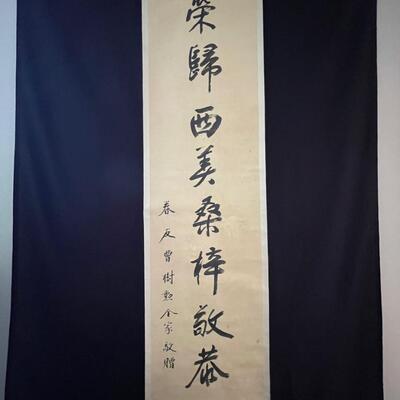
#510 ITEM: Antique Chinese Hanging Calligraphic Scroll DESCRIPTION: The fine art of Chinese calligraphy/scroll painting has been a particularly venerated art in China for centuries, and often taught by Buddhist masters. This antique scroll displays a finely painted vertical, single-line arrangement of calligraphic characters that create an appropriate expression of blessing and good will, and has been traditionally mounted with a fabric support border laid down on heavy scroll paper. SIZE: 17 x 65.5 inches PRICE: $ 210. ---------- ABOUT: Chinese/Japanese Tea Ceremony Scroll. The Chinese Tea Ceremony scroll, often written by famous calligraphers, and later copied by buddhist monks, tea masters, or iemotos are traditionally hung in the tokonoma (alcove) of the tea room. The calligraphy scrolls may be writings of Chinese Zen priests or priests of the Daitokuji Temple in Kyoto. They may also be calligraphy written by emperors, court nobles, and women between the tenth and thirteenth centuries (Heian Period), or they may be letters and poems by tea masters. Each scroll is selected by the tea master for their appropriateness for the season, time of day, or special ceremony. The scroll is hand painted on hand-made paper that can be roll mounted and hung on the wall. Individuals often spend a life time perfecting this very revered art, some of whom are considered “national living treasures.†The vertical scrolls purpose in a tea ceremony is to set the mood, in a spiritual sense. The first thing the tea guests do is to examine and remark on the scroll and accompanying flower arrangement in the tokonoma, since they know their host has gone to a lot of trouble to find just the right things to display there. The scroll will most likely also be the subject of conversation when the tea has been served. The scrolls may contain one character or famous Buddhist sayings, descriptions of famous places, or words and phrases associated with the tea ceremony. 874 / 1707 -
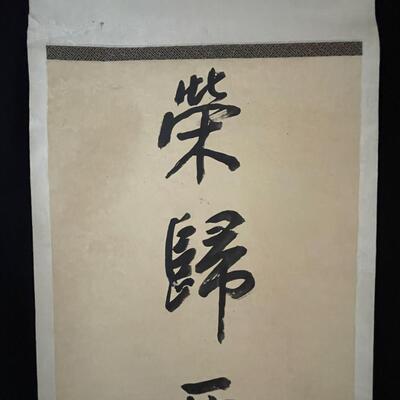
#510 ITEM: Antique Chinese Hanging Calligraphic Scroll DESCRIPTION: The fine art of Chinese calligraphy/scroll painting has been a particularly venerated art in China for centuries, and often taught by Buddhist masters. This antique scroll displays a finely painted vertical, single-line arrangement of calligraphic characters that create an appropriate expression of blessing and good will, and has been traditionally mounted with a fabric support border laid down on heavy scroll paper. SIZE: 17 x 65.5 inches PRICE: $ 210. ---------- ABOUT: Chinese/Japanese Tea Ceremony Scroll. The Chinese Tea Ceremony scroll, often written by famous calligraphers, and later copied by buddhist monks, tea masters, or iemotos are traditionally hung in the tokonoma (alcove) of the tea room. The calligraphy scrolls may be writings of Chinese Zen priests or priests of the Daitokuji Temple in Kyoto. They may also be calligraphy written by emperors, court nobles, and women between the tenth and thirteenth centuries (Heian Period), or they may be letters and poems by tea masters. Each scroll is selected by the tea master for their appropriateness for the season, time of day, or special ceremony. The scroll is hand painted on hand-made paper that can be roll mounted and hung on the wall. Individuals often spend a life time perfecting this very revered art, some of whom are considered “national living treasures.†The vertical scrolls purpose in a tea ceremony is to set the mood, in a spiritual sense. The first thing the tea guests do is to examine and remark on the scroll and accompanying flower arrangement in the tokonoma, since they know their host has gone to a lot of trouble to find just the right things to display there. The scroll will most likely also be the subject of conversation when the tea has been served. The scrolls may contain one character or famous Buddhist sayings, descriptions of famous places, or words and phrases associated with the tea ceremony. 875 / 1707 -
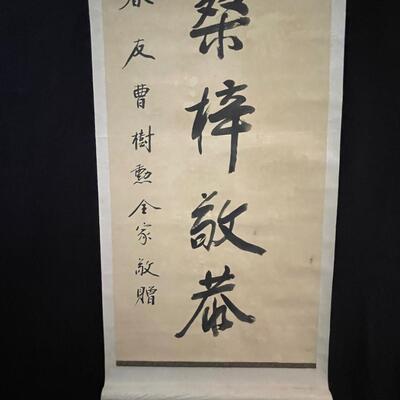
#510 ITEM: Antique Chinese Hanging Calligraphic Scroll DESCRIPTION: The fine art of Chinese calligraphy/scroll painting has been a particularly venerated art in China for centuries, and often taught by Buddhist masters. This antique scroll displays a finely painted vertical, single-line arrangement of calligraphic characters that create an appropriate expression of blessing and good will, and has been traditionally mounted with a fabric support border laid down on heavy scroll paper. SIZE: 17 x 65.5 inches PRICE: $ 210. ---------- ABOUT: Chinese/Japanese Tea Ceremony Scroll. The Chinese Tea Ceremony scroll, often written by famous calligraphers, and later copied by buddhist monks, tea masters, or iemotos are traditionally hung in the tokonoma (alcove) of the tea room. The calligraphy scrolls may be writings of Chinese Zen priests or priests of the Daitokuji Temple in Kyoto. They may also be calligraphy written by emperors, court nobles, and women between the tenth and thirteenth centuries (Heian Period), or they may be letters and poems by tea masters. Each scroll is selected by the tea master for their appropriateness for the season, time of day, or special ceremony. The scroll is hand painted on hand-made paper that can be roll mounted and hung on the wall. Individuals often spend a life time perfecting this very revered art, some of whom are considered “national living treasures.†The vertical scrolls purpose in a tea ceremony is to set the mood, in a spiritual sense. The first thing the tea guests do is to examine and remark on the scroll and accompanying flower arrangement in the tokonoma, since they know their host has gone to a lot of trouble to find just the right things to display there. The scroll will most likely also be the subject of conversation when the tea has been served. The scrolls may contain one character or famous Buddhist sayings, descriptions of famous places, or words and phrases associated with the tea ceremony. 876 / 1707 -
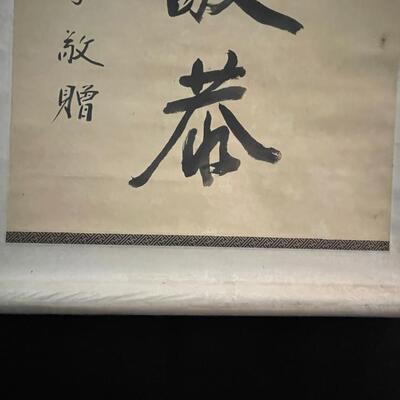
#510 ITEM: Antique Chinese Hanging Calligraphic Scroll DESCRIPTION: The fine art of Chinese calligraphy/scroll painting has been a particularly venerated art in China for centuries, and often taught by Buddhist masters. This antique scroll displays a finely painted vertical, single-line arrangement of calligraphic characters that create an appropriate expression of blessing and good will, and has been traditionally mounted with a fabric support border laid down on heavy scroll paper. SIZE: 17 x 65.5 inches PRICE: $ 210. ---------- ABOUT: Chinese/Japanese Tea Ceremony Scroll. The Chinese Tea Ceremony scroll, often written by famous calligraphers, and later copied by buddhist monks, tea masters, or iemotos are traditionally hung in the tokonoma (alcove) of the tea room. The calligraphy scrolls may be writings of Chinese Zen priests or priests of the Daitokuji Temple in Kyoto. They may also be calligraphy written by emperors, court nobles, and women between the tenth and thirteenth centuries (Heian Period), or they may be letters and poems by tea masters. Each scroll is selected by the tea master for their appropriateness for the season, time of day, or special ceremony. The scroll is hand painted on hand-made paper that can be roll mounted and hung on the wall. Individuals often spend a life time perfecting this very revered art, some of whom are considered “national living treasures.†The vertical scrolls purpose in a tea ceremony is to set the mood, in a spiritual sense. The first thing the tea guests do is to examine and remark on the scroll and accompanying flower arrangement in the tokonoma, since they know their host has gone to a lot of trouble to find just the right things to display there. The scroll will most likely also be the subject of conversation when the tea has been served. The scrolls may contain one character or famous Buddhist sayings, descriptions of famous places, or words and phrases associated with the tea ceremony. 877 / 1707 -
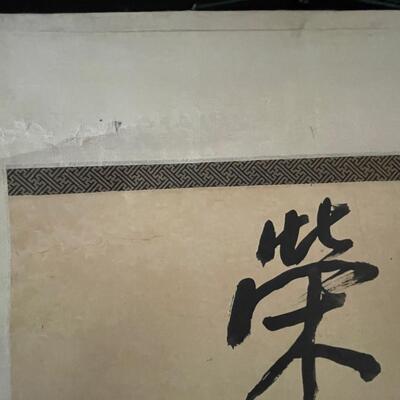
#510 ITEM: Antique Chinese Hanging Calligraphic Scroll DESCRIPTION: The fine art of Chinese calligraphy/scroll painting has been a particularly venerated art in China for centuries, and often taught by Buddhist masters. This antique scroll displays a finely painted vertical, single-line arrangement of calligraphic characters that create an appropriate expression of blessing and good will, and has been traditionally mounted with a fabric support border laid down on heavy scroll paper. SIZE: 17 x 65.5 inches PRICE: $ 210. ---------- ABOUT: Chinese/Japanese Tea Ceremony Scroll. The Chinese Tea Ceremony scroll, often written by famous calligraphers, and later copied by buddhist monks, tea masters, or iemotos are traditionally hung in the tokonoma (alcove) of the tea room. The calligraphy scrolls may be writings of Chinese Zen priests or priests of the Daitokuji Temple in Kyoto. They may also be calligraphy written by emperors, court nobles, and women between the tenth and thirteenth centuries (Heian Period), or they may be letters and poems by tea masters. Each scroll is selected by the tea master for their appropriateness for the season, time of day, or special ceremony. The scroll is hand painted on hand-made paper that can be roll mounted and hung on the wall. Individuals often spend a life time perfecting this very revered art, some of whom are considered “national living treasures.†The vertical scrolls purpose in a tea ceremony is to set the mood, in a spiritual sense. The first thing the tea guests do is to examine and remark on the scroll and accompanying flower arrangement in the tokonoma, since they know their host has gone to a lot of trouble to find just the right things to display there. The scroll will most likely also be the subject of conversation when the tea has been served. The scrolls may contain one character or famous Buddhist sayings, descriptions of famous places, or words and phrases associated with the tea ceremony. 878 / 1707 -
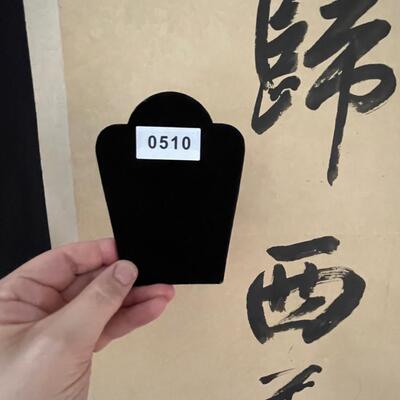
#510 ITEM: Antique Chinese Hanging Calligraphic Scroll DESCRIPTION: The fine art of Chinese calligraphy/scroll painting has been a particularly venerated art in China for centuries, and often taught by Buddhist masters. This antique scroll displays a finely painted vertical, single-line arrangement of calligraphic characters that create an appropriate expression of blessing and good will, and has been traditionally mounted with a fabric support border laid down on heavy scroll paper. SIZE: 17 x 65.5 inches PRICE: $ 210. ---------- ABOUT: Chinese/Japanese Tea Ceremony Scroll. The Chinese Tea Ceremony scroll, often written by famous calligraphers, and later copied by buddhist monks, tea masters, or iemotos are traditionally hung in the tokonoma (alcove) of the tea room. The calligraphy scrolls may be writings of Chinese Zen priests or priests of the Daitokuji Temple in Kyoto. They may also be calligraphy written by emperors, court nobles, and women between the tenth and thirteenth centuries (Heian Period), or they may be letters and poems by tea masters. Each scroll is selected by the tea master for their appropriateness for the season, time of day, or special ceremony. The scroll is hand painted on hand-made paper that can be roll mounted and hung on the wall. Individuals often spend a life time perfecting this very revered art, some of whom are considered “national living treasures.†The vertical scrolls purpose in a tea ceremony is to set the mood, in a spiritual sense. The first thing the tea guests do is to examine and remark on the scroll and accompanying flower arrangement in the tokonoma, since they know their host has gone to a lot of trouble to find just the right things to display there. The scroll will most likely also be the subject of conversation when the tea has been served. The scrolls may contain one character or famous Buddhist sayings, descriptions of famous places, or words and phrases associated with the tea ceremony. 879 / 1707 -
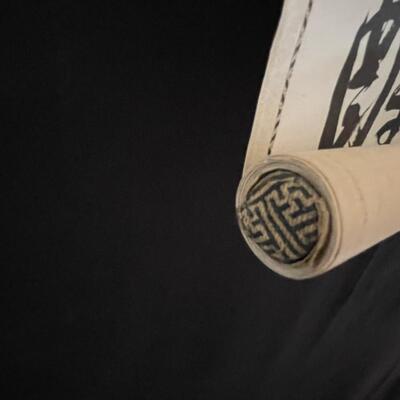
#512 ITEM: Antique Chinese Hanging Calligraphic Scroll DESCRIPTION: This Antique scroll displays a finely painted vertical, triple-line arrangement of calligraphic characters that create an appropriate expression of blessing and good will, and has been traditionally mounted with a fabric support border laid down on heavy scroll paper. The attention to detail and quality on these makes them much better than average. SIZE: 14.5 x 61.5 inches PRICE: $275. ---- ABOUT: Chinese/Japanese Tea Ceremony Scroll. The Chinese Tea Ceremony scroll, often written by famous calligraphers, and later copied by buddhist monks, tea masters, or iemotos are traditionally hung in the tokonoma (alcove) of the tea room. The calligraphy scrolls may be writings of Chinese Zen priests or priests of the Daitokuji Temple in Kyoto. They may also be calligraphy written by emperors, court nobles, and women between the tenth and thirteenth centuries (Heian Period), or they may be letters and poems by tea masters. Each scroll is selected by the tea master for their appropriateness for the season, time of day, or special ceremony. The scroll is hand painted on hand-made paper that can be roll mounted and hung on the wall. Individuals often spend a life time perfecting this very revered art, some of whom are considered “national living treasures.†The vertical scrolls purpose in a tea ceremony is to set the mood, in a spiritual sense. The first thing the tea guests do is to examine and remark on the scroll and accompanying flower arrangement in the tokonoma, since they know their host has gone to a lot of trouble to find just the right things to display there. The scroll will most likely also be the subject of conversation when the tea has been served. The scrolls may contain one character or famous Buddhist sayings, descriptions of famous places, or words and phrases associated with the tea ceremony. 880 / 1707 sold -
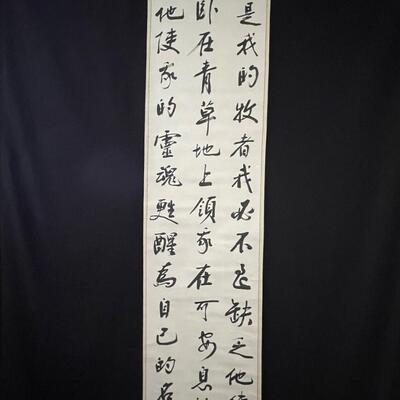
#512 ITEM: Antique Chinese Hanging Calligraphic Scroll DESCRIPTION: This Antique scroll displays a finely painted vertical, triple-line arrangement of calligraphic characters that create an appropriate expression of blessing and good will, and has been traditionally mounted with a fabric support border laid down on heavy scroll paper. The attention to detail and quality on these makes them much better than average. SIZE: 14.5 x 61.5 inches PRICE: $275. ---- ABOUT: Chinese/Japanese Tea Ceremony Scroll. The Chinese Tea Ceremony scroll, often written by famous calligraphers, and later copied by buddhist monks, tea masters, or iemotos are traditionally hung in the tokonoma (alcove) of the tea room. The calligraphy scrolls may be writings of Chinese Zen priests or priests of the Daitokuji Temple in Kyoto. They may also be calligraphy written by emperors, court nobles, and women between the tenth and thirteenth centuries (Heian Period), or they may be letters and poems by tea masters. Each scroll is selected by the tea master for their appropriateness for the season, time of day, or special ceremony. The scroll is hand painted on hand-made paper that can be roll mounted and hung on the wall. Individuals often spend a life time perfecting this very revered art, some of whom are considered “national living treasures.†The vertical scrolls purpose in a tea ceremony is to set the mood, in a spiritual sense. The first thing the tea guests do is to examine and remark on the scroll and accompanying flower arrangement in the tokonoma, since they know their host has gone to a lot of trouble to find just the right things to display there. The scroll will most likely also be the subject of conversation when the tea has been served. The scrolls may contain one character or famous Buddhist sayings, descriptions of famous places, or words and phrases associated with the tea ceremony. 881 / 1707 sold -
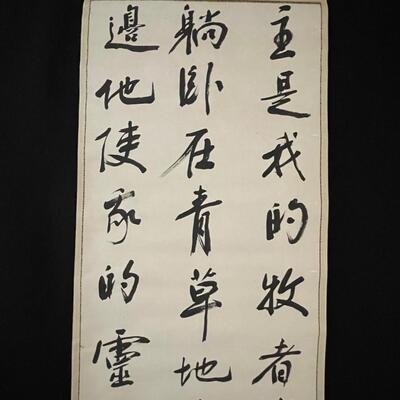
#512 ITEM: Antique Chinese Hanging Calligraphic Scroll DESCRIPTION: This Antique scroll displays a finely painted vertical, triple-line arrangement of calligraphic characters that create an appropriate expression of blessing and good will, and has been traditionally mounted with a fabric support border laid down on heavy scroll paper. The attention to detail and quality on these makes them much better than average. SIZE: 14.5 x 61.5 inches PRICE: $275. ---- ABOUT: Chinese/Japanese Tea Ceremony Scroll. The Chinese Tea Ceremony scroll, often written by famous calligraphers, and later copied by buddhist monks, tea masters, or iemotos are traditionally hung in the tokonoma (alcove) of the tea room. The calligraphy scrolls may be writings of Chinese Zen priests or priests of the Daitokuji Temple in Kyoto. They may also be calligraphy written by emperors, court nobles, and women between the tenth and thirteenth centuries (Heian Period), or they may be letters and poems by tea masters. Each scroll is selected by the tea master for their appropriateness for the season, time of day, or special ceremony. The scroll is hand painted on hand-made paper that can be roll mounted and hung on the wall. Individuals often spend a life time perfecting this very revered art, some of whom are considered “national living treasures.†The vertical scrolls purpose in a tea ceremony is to set the mood, in a spiritual sense. The first thing the tea guests do is to examine and remark on the scroll and accompanying flower arrangement in the tokonoma, since they know their host has gone to a lot of trouble to find just the right things to display there. The scroll will most likely also be the subject of conversation when the tea has been served. The scrolls may contain one character or famous Buddhist sayings, descriptions of famous places, or words and phrases associated with the tea ceremony. 882 / 1707 sold -
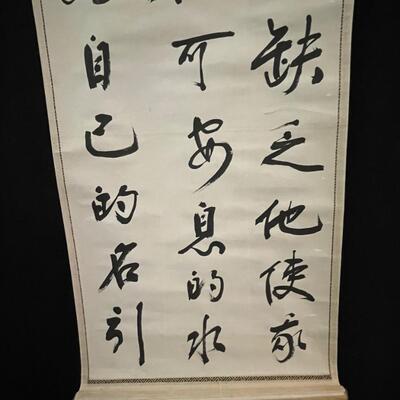
#512 ITEM: Antique Chinese Hanging Calligraphic Scroll DESCRIPTION: This Antique scroll displays a finely painted vertical, triple-line arrangement of calligraphic characters that create an appropriate expression of blessing and good will, and has been traditionally mounted with a fabric support border laid down on heavy scroll paper. The attention to detail and quality on these makes them much better than average. SIZE: 14.5 x 61.5 inches PRICE: $275. ---- ABOUT: Chinese/Japanese Tea Ceremony Scroll. The Chinese Tea Ceremony scroll, often written by famous calligraphers, and later copied by buddhist monks, tea masters, or iemotos are traditionally hung in the tokonoma (alcove) of the tea room. The calligraphy scrolls may be writings of Chinese Zen priests or priests of the Daitokuji Temple in Kyoto. They may also be calligraphy written by emperors, court nobles, and women between the tenth and thirteenth centuries (Heian Period), or they may be letters and poems by tea masters. Each scroll is selected by the tea master for their appropriateness for the season, time of day, or special ceremony. The scroll is hand painted on hand-made paper that can be roll mounted and hung on the wall. Individuals often spend a life time perfecting this very revered art, some of whom are considered “national living treasures.†The vertical scrolls purpose in a tea ceremony is to set the mood, in a spiritual sense. The first thing the tea guests do is to examine and remark on the scroll and accompanying flower arrangement in the tokonoma, since they know their host has gone to a lot of trouble to find just the right things to display there. The scroll will most likely also be the subject of conversation when the tea has been served. The scrolls may contain one character or famous Buddhist sayings, descriptions of famous places, or words and phrases associated with the tea ceremony. 883 / 1707 sold -
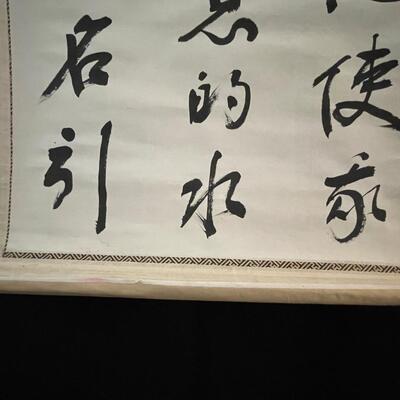
#512 ITEM: Antique Chinese Hanging Calligraphic Scroll DESCRIPTION: This Antique scroll displays a finely painted vertical, triple-line arrangement of calligraphic characters that create an appropriate expression of blessing and good will, and has been traditionally mounted with a fabric support border laid down on heavy scroll paper. The attention to detail and quality on these makes them much better than average. SIZE: 14.5 x 61.5 inches PRICE: $275. ---- ABOUT: Chinese/Japanese Tea Ceremony Scroll. The Chinese Tea Ceremony scroll, often written by famous calligraphers, and later copied by buddhist monks, tea masters, or iemotos are traditionally hung in the tokonoma (alcove) of the tea room. The calligraphy scrolls may be writings of Chinese Zen priests or priests of the Daitokuji Temple in Kyoto. They may also be calligraphy written by emperors, court nobles, and women between the tenth and thirteenth centuries (Heian Period), or they may be letters and poems by tea masters. Each scroll is selected by the tea master for their appropriateness for the season, time of day, or special ceremony. The scroll is hand painted on hand-made paper that can be roll mounted and hung on the wall. Individuals often spend a life time perfecting this very revered art, some of whom are considered “national living treasures.†The vertical scrolls purpose in a tea ceremony is to set the mood, in a spiritual sense. The first thing the tea guests do is to examine and remark on the scroll and accompanying flower arrangement in the tokonoma, since they know their host has gone to a lot of trouble to find just the right things to display there. The scroll will most likely also be the subject of conversation when the tea has been served. The scrolls may contain one character or famous Buddhist sayings, descriptions of famous places, or words and phrases associated with the tea ceremony. 884 / 1707 sold -

#512 ITEM: Antique Chinese Hanging Calligraphic Scroll DESCRIPTION: This Antique scroll displays a finely painted vertical, triple-line arrangement of calligraphic characters that create an appropriate expression of blessing and good will, and has been traditionally mounted with a fabric support border laid down on heavy scroll paper. The attention to detail and quality on these makes them much better than average. SIZE: 14.5 x 61.5 inches PRICE: $275. ---- ABOUT: Chinese/Japanese Tea Ceremony Scroll. The Chinese Tea Ceremony scroll, often written by famous calligraphers, and later copied by buddhist monks, tea masters, or iemotos are traditionally hung in the tokonoma (alcove) of the tea room. The calligraphy scrolls may be writings of Chinese Zen priests or priests of the Daitokuji Temple in Kyoto. They may also be calligraphy written by emperors, court nobles, and women between the tenth and thirteenth centuries (Heian Period), or they may be letters and poems by tea masters. Each scroll is selected by the tea master for their appropriateness for the season, time of day, or special ceremony. The scroll is hand painted on hand-made paper that can be roll mounted and hung on the wall. Individuals often spend a life time perfecting this very revered art, some of whom are considered “national living treasures.†The vertical scrolls purpose in a tea ceremony is to set the mood, in a spiritual sense. The first thing the tea guests do is to examine and remark on the scroll and accompanying flower arrangement in the tokonoma, since they know their host has gone to a lot of trouble to find just the right things to display there. The scroll will most likely also be the subject of conversation when the tea has been served. The scrolls may contain one character or famous Buddhist sayings, descriptions of famous places, or words and phrases associated with the tea ceremony. 885 / 1707 sold -
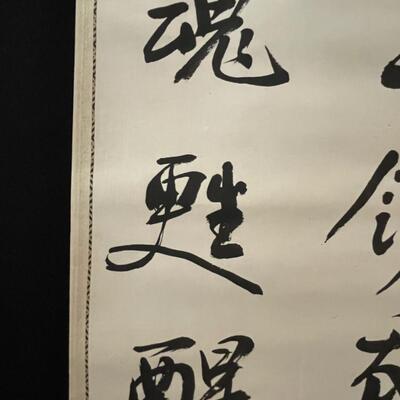
#512 ITEM: Antique Chinese Hanging Calligraphic Scroll DESCRIPTION: This Antique scroll displays a finely painted vertical, triple-line arrangement of calligraphic characters that create an appropriate expression of blessing and good will, and has been traditionally mounted with a fabric support border laid down on heavy scroll paper. The attention to detail and quality on these makes them much better than average. SIZE: 14.5 x 61.5 inches PRICE: $275. ---- ABOUT: Chinese/Japanese Tea Ceremony Scroll. The Chinese Tea Ceremony scroll, often written by famous calligraphers, and later copied by buddhist monks, tea masters, or iemotos are traditionally hung in the tokonoma (alcove) of the tea room. The calligraphy scrolls may be writings of Chinese Zen priests or priests of the Daitokuji Temple in Kyoto. They may also be calligraphy written by emperors, court nobles, and women between the tenth and thirteenth centuries (Heian Period), or they may be letters and poems by tea masters. Each scroll is selected by the tea master for their appropriateness for the season, time of day, or special ceremony. The scroll is hand painted on hand-made paper that can be roll mounted and hung on the wall. Individuals often spend a life time perfecting this very revered art, some of whom are considered “national living treasures.†The vertical scrolls purpose in a tea ceremony is to set the mood, in a spiritual sense. The first thing the tea guests do is to examine and remark on the scroll and accompanying flower arrangement in the tokonoma, since they know their host has gone to a lot of trouble to find just the right things to display there. The scroll will most likely also be the subject of conversation when the tea has been served. The scrolls may contain one character or famous Buddhist sayings, descriptions of famous places, or words and phrases associated with the tea ceremony. 886 / 1707 sold -
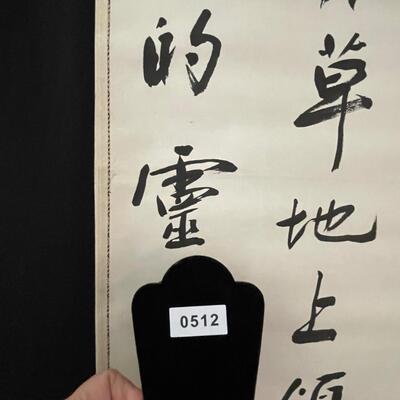
#512 ITEM: Antique Chinese Hanging Calligraphic Scroll DESCRIPTION: This Antique scroll displays a finely painted vertical, triple-line arrangement of calligraphic characters that create an appropriate expression of blessing and good will, and has been traditionally mounted with a fabric support border laid down on heavy scroll paper. The attention to detail and quality on these makes them much better than average. SIZE: 14.5 x 61.5 inches PRICE: $275. ---- ABOUT: Chinese/Japanese Tea Ceremony Scroll. The Chinese Tea Ceremony scroll, often written by famous calligraphers, and later copied by buddhist monks, tea masters, or iemotos are traditionally hung in the tokonoma (alcove) of the tea room. The calligraphy scrolls may be writings of Chinese Zen priests or priests of the Daitokuji Temple in Kyoto. They may also be calligraphy written by emperors, court nobles, and women between the tenth and thirteenth centuries (Heian Period), or they may be letters and poems by tea masters. Each scroll is selected by the tea master for their appropriateness for the season, time of day, or special ceremony. The scroll is hand painted on hand-made paper that can be roll mounted and hung on the wall. Individuals often spend a life time perfecting this very revered art, some of whom are considered “national living treasures.†The vertical scrolls purpose in a tea ceremony is to set the mood, in a spiritual sense. The first thing the tea guests do is to examine and remark on the scroll and accompanying flower arrangement in the tokonoma, since they know their host has gone to a lot of trouble to find just the right things to display there. The scroll will most likely also be the subject of conversation when the tea has been served. The scrolls may contain one character or famous Buddhist sayings, descriptions of famous places, or words and phrases associated with the tea ceremony. 887 / 1707 sold -
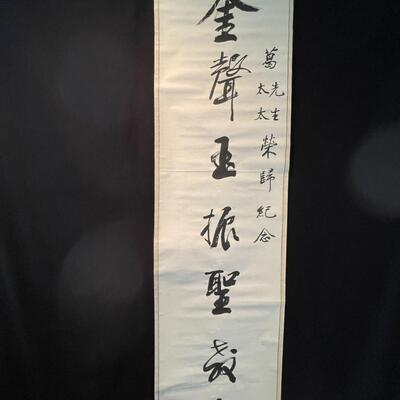
#514 ITEM: A Antique Chinese Hanging Calligraphic Scroll DESCRIPTION: This scroll displays an interesting arrangement of both large and small vertically arranged calligraphic characters artfully arranged on a traditionally mounted foundation framed with a fabric ribbon border. SIZE: 14.5 x 61.5 inches PRICE: $ 145. ------- ABOUT: The Chinese Tea Ceremony scroll, often written by famous calligraphers, and later copied by buddhist monks, tea masters, or iemotos are traditionally hung in the tokonoma (alcove) of the tea room. The calligraphy scrolls may be writings of Chinese Zen priests or priests of the Daitokuji Temple in Kyoto. They may also be calligraphy written by emperors, court nobles, and women between the tenth and thirteenth centuries (Heian Period), or they may be letters and poems by tea masters. Each scroll is selected by the tea master for their appropriateness for the season, time of day, or special ceremony. The scroll is hand painted on hand-made paper that can be roll mounted and hung on the wall. Individuals often spend a life time perfecting this very revered art, some of whom are considered “national living treasures.†The vertical scrolls purpose in a tea ceremony is to set the mood, in a spiritual sense. The first thing the tea guests do is to examine and remark on the scroll and accompanying flower arrangement in the tokonoma, since they know their host has gone to a lot of trouble to find just the right things to display there. The scroll will most likely also be the subject of conversation when the tea has been served. The scrolls may contain one character or famous Buddhist sayings, descriptions of famous places, or words and phrases associated with the tea ceremony. 888 / 1707 -

#514 ITEM: A Antique Chinese Hanging Calligraphic Scroll DESCRIPTION: This scroll displays an interesting arrangement of both large and small vertically arranged calligraphic characters artfully arranged on a traditionally mounted foundation framed with a fabric ribbon border. SIZE: 14.5 x 61.5 inches PRICE: $ 145. ------- ABOUT: The Chinese Tea Ceremony scroll, often written by famous calligraphers, and later copied by buddhist monks, tea masters, or iemotos are traditionally hung in the tokonoma (alcove) of the tea room. The calligraphy scrolls may be writings of Chinese Zen priests or priests of the Daitokuji Temple in Kyoto. They may also be calligraphy written by emperors, court nobles, and women between the tenth and thirteenth centuries (Heian Period), or they may be letters and poems by tea masters. Each scroll is selected by the tea master for their appropriateness for the season, time of day, or special ceremony. The scroll is hand painted on hand-made paper that can be roll mounted and hung on the wall. Individuals often spend a life time perfecting this very revered art, some of whom are considered “national living treasures.†The vertical scrolls purpose in a tea ceremony is to set the mood, in a spiritual sense. The first thing the tea guests do is to examine and remark on the scroll and accompanying flower arrangement in the tokonoma, since they know their host has gone to a lot of trouble to find just the right things to display there. The scroll will most likely also be the subject of conversation when the tea has been served. The scrolls may contain one character or famous Buddhist sayings, descriptions of famous places, or words and phrases associated with the tea ceremony. 889 / 1707 -
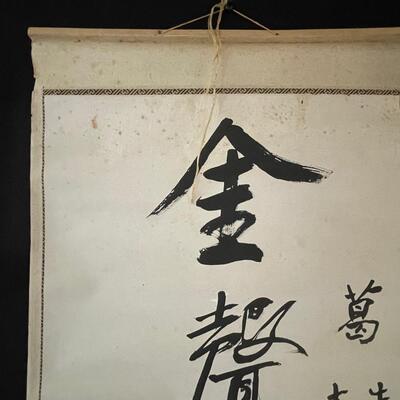
#514 ITEM: A Antique Chinese Hanging Calligraphic Scroll DESCRIPTION: This scroll displays an interesting arrangement of both large and small vertically arranged calligraphic characters artfully arranged on a traditionally mounted foundation framed with a fabric ribbon border. SIZE: 14.5 x 61.5 inches PRICE: $ 145. ------- ABOUT: The Chinese Tea Ceremony scroll, often written by famous calligraphers, and later copied by buddhist monks, tea masters, or iemotos are traditionally hung in the tokonoma (alcove) of the tea room. The calligraphy scrolls may be writings of Chinese Zen priests or priests of the Daitokuji Temple in Kyoto. They may also be calligraphy written by emperors, court nobles, and women between the tenth and thirteenth centuries (Heian Period), or they may be letters and poems by tea masters. Each scroll is selected by the tea master for their appropriateness for the season, time of day, or special ceremony. The scroll is hand painted on hand-made paper that can be roll mounted and hung on the wall. Individuals often spend a life time perfecting this very revered art, some of whom are considered “national living treasures.†The vertical scrolls purpose in a tea ceremony is to set the mood, in a spiritual sense. The first thing the tea guests do is to examine and remark on the scroll and accompanying flower arrangement in the tokonoma, since they know their host has gone to a lot of trouble to find just the right things to display there. The scroll will most likely also be the subject of conversation when the tea has been served. The scrolls may contain one character or famous Buddhist sayings, descriptions of famous places, or words and phrases associated with the tea ceremony. 890 / 1707 -
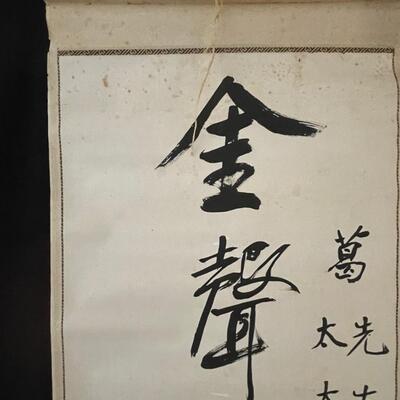
#514 ITEM: A Antique Chinese Hanging Calligraphic Scroll DESCRIPTION: This scroll displays an interesting arrangement of both large and small vertically arranged calligraphic characters artfully arranged on a traditionally mounted foundation framed with a fabric ribbon border. SIZE: 14.5 x 61.5 inches PRICE: $ 145. ------- ABOUT: The Chinese Tea Ceremony scroll, often written by famous calligraphers, and later copied by buddhist monks, tea masters, or iemotos are traditionally hung in the tokonoma (alcove) of the tea room. The calligraphy scrolls may be writings of Chinese Zen priests or priests of the Daitokuji Temple in Kyoto. They may also be calligraphy written by emperors, court nobles, and women between the tenth and thirteenth centuries (Heian Period), or they may be letters and poems by tea masters. Each scroll is selected by the tea master for their appropriateness for the season, time of day, or special ceremony. The scroll is hand painted on hand-made paper that can be roll mounted and hung on the wall. Individuals often spend a life time perfecting this very revered art, some of whom are considered “national living treasures.†The vertical scrolls purpose in a tea ceremony is to set the mood, in a spiritual sense. The first thing the tea guests do is to examine and remark on the scroll and accompanying flower arrangement in the tokonoma, since they know their host has gone to a lot of trouble to find just the right things to display there. The scroll will most likely also be the subject of conversation when the tea has been served. The scrolls may contain one character or famous Buddhist sayings, descriptions of famous places, or words and phrases associated with the tea ceremony. 891 / 1707 -
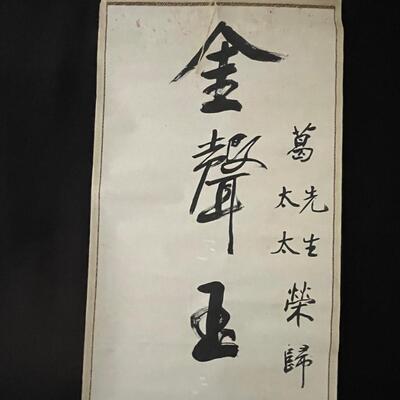
#514 ITEM: A Antique Chinese Hanging Calligraphic Scroll DESCRIPTION: This scroll displays an interesting arrangement of both large and small vertically arranged calligraphic characters artfully arranged on a traditionally mounted foundation framed with a fabric ribbon border. SIZE: 14.5 x 61.5 inches PRICE: $ 145. ------- ABOUT: The Chinese Tea Ceremony scroll, often written by famous calligraphers, and later copied by buddhist monks, tea masters, or iemotos are traditionally hung in the tokonoma (alcove) of the tea room. The calligraphy scrolls may be writings of Chinese Zen priests or priests of the Daitokuji Temple in Kyoto. They may also be calligraphy written by emperors, court nobles, and women between the tenth and thirteenth centuries (Heian Period), or they may be letters and poems by tea masters. Each scroll is selected by the tea master for their appropriateness for the season, time of day, or special ceremony. The scroll is hand painted on hand-made paper that can be roll mounted and hung on the wall. Individuals often spend a life time perfecting this very revered art, some of whom are considered “national living treasures.†The vertical scrolls purpose in a tea ceremony is to set the mood, in a spiritual sense. The first thing the tea guests do is to examine and remark on the scroll and accompanying flower arrangement in the tokonoma, since they know their host has gone to a lot of trouble to find just the right things to display there. The scroll will most likely also be the subject of conversation when the tea has been served. The scrolls may contain one character or famous Buddhist sayings, descriptions of famous places, or words and phrases associated with the tea ceremony. 892 / 1707 -
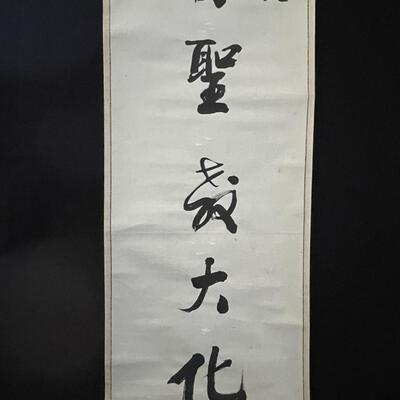
#514 ITEM: A Antique Chinese Hanging Calligraphic Scroll DESCRIPTION: This scroll displays an interesting arrangement of both large and small vertically arranged calligraphic characters artfully arranged on a traditionally mounted foundation framed with a fabric ribbon border. SIZE: 14.5 x 61.5 inches PRICE: $ 145. ------- ABOUT: The Chinese Tea Ceremony scroll, often written by famous calligraphers, and later copied by buddhist monks, tea masters, or iemotos are traditionally hung in the tokonoma (alcove) of the tea room. The calligraphy scrolls may be writings of Chinese Zen priests or priests of the Daitokuji Temple in Kyoto. They may also be calligraphy written by emperors, court nobles, and women between the tenth and thirteenth centuries (Heian Period), or they may be letters and poems by tea masters. Each scroll is selected by the tea master for their appropriateness for the season, time of day, or special ceremony. The scroll is hand painted on hand-made paper that can be roll mounted and hung on the wall. Individuals often spend a life time perfecting this very revered art, some of whom are considered “national living treasures.†The vertical scrolls purpose in a tea ceremony is to set the mood, in a spiritual sense. The first thing the tea guests do is to examine and remark on the scroll and accompanying flower arrangement in the tokonoma, since they know their host has gone to a lot of trouble to find just the right things to display there. The scroll will most likely also be the subject of conversation when the tea has been served. The scrolls may contain one character or famous Buddhist sayings, descriptions of famous places, or words and phrases associated with the tea ceremony. 893 / 1707 -
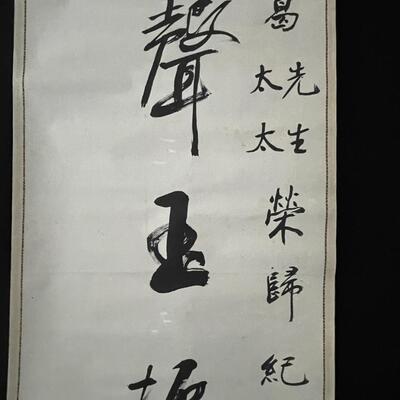
#514 ITEM: A Antique Chinese Hanging Calligraphic Scroll DESCRIPTION: This scroll displays an interesting arrangement of both large and small vertically arranged calligraphic characters artfully arranged on a traditionally mounted foundation framed with a fabric ribbon border. SIZE: 14.5 x 61.5 inches PRICE: $ 145. ------- ABOUT: The Chinese Tea Ceremony scroll, often written by famous calligraphers, and later copied by buddhist monks, tea masters, or iemotos are traditionally hung in the tokonoma (alcove) of the tea room. The calligraphy scrolls may be writings of Chinese Zen priests or priests of the Daitokuji Temple in Kyoto. They may also be calligraphy written by emperors, court nobles, and women between the tenth and thirteenth centuries (Heian Period), or they may be letters and poems by tea masters. Each scroll is selected by the tea master for their appropriateness for the season, time of day, or special ceremony. The scroll is hand painted on hand-made paper that can be roll mounted and hung on the wall. Individuals often spend a life time perfecting this very revered art, some of whom are considered “national living treasures.†The vertical scrolls purpose in a tea ceremony is to set the mood, in a spiritual sense. The first thing the tea guests do is to examine and remark on the scroll and accompanying flower arrangement in the tokonoma, since they know their host has gone to a lot of trouble to find just the right things to display there. The scroll will most likely also be the subject of conversation when the tea has been served. The scrolls may contain one character or famous Buddhist sayings, descriptions of famous places, or words and phrases associated with the tea ceremony. 894 / 1707 -

#514 ITEM: A Antique Chinese Hanging Calligraphic Scroll DESCRIPTION: This scroll displays an interesting arrangement of both large and small vertically arranged calligraphic characters artfully arranged on a traditionally mounted foundation framed with a fabric ribbon border. SIZE: 14.5 x 61.5 inches PRICE: $ 145. ------- ABOUT: The Chinese Tea Ceremony scroll, often written by famous calligraphers, and later copied by buddhist monks, tea masters, or iemotos are traditionally hung in the tokonoma (alcove) of the tea room. The calligraphy scrolls may be writings of Chinese Zen priests or priests of the Daitokuji Temple in Kyoto. They may also be calligraphy written by emperors, court nobles, and women between the tenth and thirteenth centuries (Heian Period), or they may be letters and poems by tea masters. Each scroll is selected by the tea master for their appropriateness for the season, time of day, or special ceremony. The scroll is hand painted on hand-made paper that can be roll mounted and hung on the wall. Individuals often spend a life time perfecting this very revered art, some of whom are considered “national living treasures.†The vertical scrolls purpose in a tea ceremony is to set the mood, in a spiritual sense. The first thing the tea guests do is to examine and remark on the scroll and accompanying flower arrangement in the tokonoma, since they know their host has gone to a lot of trouble to find just the right things to display there. The scroll will most likely also be the subject of conversation when the tea has been served. The scrolls may contain one character or famous Buddhist sayings, descriptions of famous places, or words and phrases associated with the tea ceremony. 895 / 1707 -
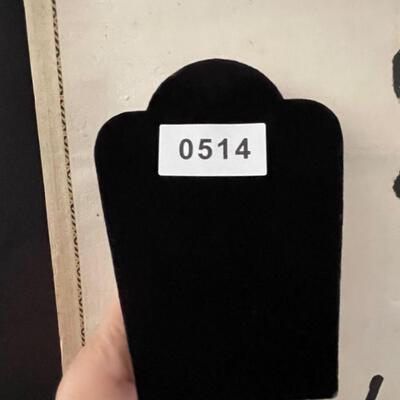
#514 ITEM: A Antique Chinese Hanging Calligraphic Scroll DESCRIPTION: This scroll displays an interesting arrangement of both large and small vertically arranged calligraphic characters artfully arranged on a traditionally mounted foundation framed with a fabric ribbon border. SIZE: 14.5 x 61.5 inches PRICE: $ 145. ------- ABOUT: The Chinese Tea Ceremony scroll, often written by famous calligraphers, and later copied by buddhist monks, tea masters, or iemotos are traditionally hung in the tokonoma (alcove) of the tea room. The calligraphy scrolls may be writings of Chinese Zen priests or priests of the Daitokuji Temple in Kyoto. They may also be calligraphy written by emperors, court nobles, and women between the tenth and thirteenth centuries (Heian Period), or they may be letters and poems by tea masters. Each scroll is selected by the tea master for their appropriateness for the season, time of day, or special ceremony. The scroll is hand painted on hand-made paper that can be roll mounted and hung on the wall. Individuals often spend a life time perfecting this very revered art, some of whom are considered “national living treasures.†The vertical scrolls purpose in a tea ceremony is to set the mood, in a spiritual sense. The first thing the tea guests do is to examine and remark on the scroll and accompanying flower arrangement in the tokonoma, since they know their host has gone to a lot of trouble to find just the right things to display there. The scroll will most likely also be the subject of conversation when the tea has been served. The scrolls may contain one character or famous Buddhist sayings, descriptions of famous places, or words and phrases associated with the tea ceremony. 896 / 1707 -
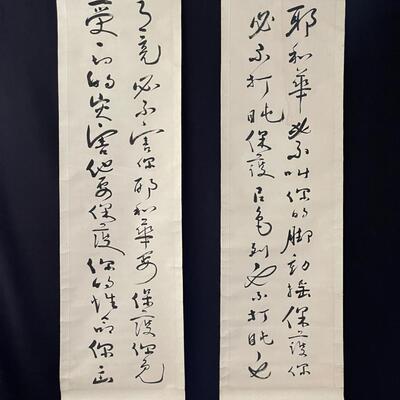
#517 ITEM: A Pair of Antique Chinese Calligraphic Scrolls DESCRIPTION: This pair of scrolls are each detailed with two vertical lines of boldly rendered calligraphic characters artfully arranged to fill the length and width of the scroll. SIZE: 11.5 x 41 inches. Each PRICE: (pair) $ 235. ------- ABOUT: The Chinese Tea Ceremony scroll, often written by famous calligraphers, and later copied by buddhist monks, tea masters, or iemotos are traditionally hung in the tokonoma (alcove) of the tea room. The calligraphy scrolls may be writings of Chinese Zen priests or priests of the Daitokuji Temple in Kyoto. They may also be calligraphy written by emperors, court nobles, and women between the tenth and thirteenth centuries (Heian Period), or they may be letters and poems by tea masters. Each scroll is selected by the tea master for their appropriateness for the season, time of day, or special ceremony. The scroll is hand painted on hand-made paper that can be roll mounted and hung on the wall. Individuals often spend a life time perfecting this very revered art, some of whom are considered “national living treasures.†The vertical scrolls purpose in a tea ceremony is to set the mood, in a spiritual sense. The first thing the tea guests do is to examine and remark on the scroll and accompanying flower arrangement in the tokonoma, since they know their host has gone to a lot of trouble to find just the right things to display there. The scroll will most likely also be the subject of conversation when the tea has been served. The scrolls may contain one character or famous Buddhist sayings, descriptions of famous places, or words and phrases associated with the tea ceremony. 897 / 1707 -

#517 ITEM: A Pair of Antique Chinese Calligraphic Scrolls DESCRIPTION: This pair of scrolls are each detailed with two vertical lines of boldly rendered calligraphic characters artfully arranged to fill the length and width of the scroll. SIZE: 11.5 x 41 inches. Each PRICE: (pair) $ 235. ------- ABOUT: The Chinese Tea Ceremony scroll, often written by famous calligraphers, and later copied by buddhist monks, tea masters, or iemotos are traditionally hung in the tokonoma (alcove) of the tea room. The calligraphy scrolls may be writings of Chinese Zen priests or priests of the Daitokuji Temple in Kyoto. They may also be calligraphy written by emperors, court nobles, and women between the tenth and thirteenth centuries (Heian Period), or they may be letters and poems by tea masters. Each scroll is selected by the tea master for their appropriateness for the season, time of day, or special ceremony. The scroll is hand painted on hand-made paper that can be roll mounted and hung on the wall. Individuals often spend a life time perfecting this very revered art, some of whom are considered “national living treasures.†The vertical scrolls purpose in a tea ceremony is to set the mood, in a spiritual sense. The first thing the tea guests do is to examine and remark on the scroll and accompanying flower arrangement in the tokonoma, since they know their host has gone to a lot of trouble to find just the right things to display there. The scroll will most likely also be the subject of conversation when the tea has been served. The scrolls may contain one character or famous Buddhist sayings, descriptions of famous places, or words and phrases associated with the tea ceremony. 898 / 1707 -
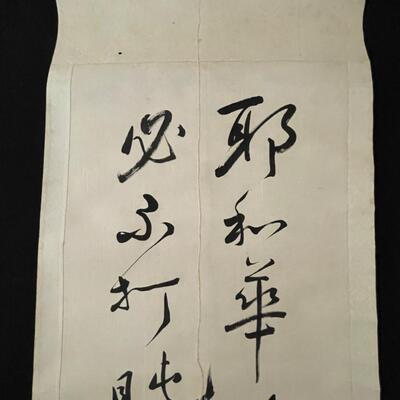
#517 ITEM: A Pair of Antique Chinese Calligraphic Scrolls DESCRIPTION: This pair of scrolls are each detailed with two vertical lines of boldly rendered calligraphic characters artfully arranged to fill the length and width of the scroll. SIZE: 11.5 x 41 inches. Each PRICE: (pair) $ 235. ------- ABOUT: The Chinese Tea Ceremony scroll, often written by famous calligraphers, and later copied by buddhist monks, tea masters, or iemotos are traditionally hung in the tokonoma (alcove) of the tea room. The calligraphy scrolls may be writings of Chinese Zen priests or priests of the Daitokuji Temple in Kyoto. They may also be calligraphy written by emperors, court nobles, and women between the tenth and thirteenth centuries (Heian Period), or they may be letters and poems by tea masters. Each scroll is selected by the tea master for their appropriateness for the season, time of day, or special ceremony. The scroll is hand painted on hand-made paper that can be roll mounted and hung on the wall. Individuals often spend a life time perfecting this very revered art, some of whom are considered “national living treasures.†The vertical scrolls purpose in a tea ceremony is to set the mood, in a spiritual sense. The first thing the tea guests do is to examine and remark on the scroll and accompanying flower arrangement in the tokonoma, since they know their host has gone to a lot of trouble to find just the right things to display there. The scroll will most likely also be the subject of conversation when the tea has been served. The scrolls may contain one character or famous Buddhist sayings, descriptions of famous places, or words and phrases associated with the tea ceremony. 899 / 1707 -
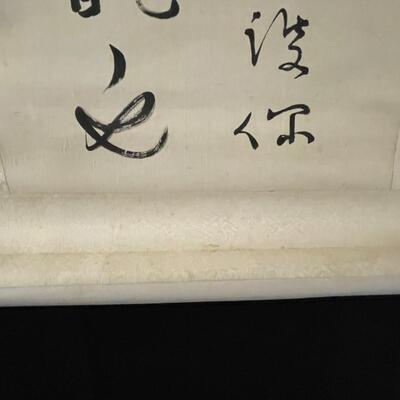
#517 ITEM: A Pair of Antique Chinese Calligraphic Scrolls DESCRIPTION: This pair of scrolls are each detailed with two vertical lines of boldly rendered calligraphic characters artfully arranged to fill the length and width of the scroll. SIZE: 11.5 x 41 inches. Each PRICE: (pair) $ 235. ------- ABOUT: The Chinese Tea Ceremony scroll, often written by famous calligraphers, and later copied by buddhist monks, tea masters, or iemotos are traditionally hung in the tokonoma (alcove) of the tea room. The calligraphy scrolls may be writings of Chinese Zen priests or priests of the Daitokuji Temple in Kyoto. They may also be calligraphy written by emperors, court nobles, and women between the tenth and thirteenth centuries (Heian Period), or they may be letters and poems by tea masters. Each scroll is selected by the tea master for their appropriateness for the season, time of day, or special ceremony. The scroll is hand painted on hand-made paper that can be roll mounted and hung on the wall. Individuals often spend a life time perfecting this very revered art, some of whom are considered “national living treasures.†The vertical scrolls purpose in a tea ceremony is to set the mood, in a spiritual sense. The first thing the tea guests do is to examine and remark on the scroll and accompanying flower arrangement in the tokonoma, since they know their host has gone to a lot of trouble to find just the right things to display there. The scroll will most likely also be the subject of conversation when the tea has been served. The scrolls may contain one character or famous Buddhist sayings, descriptions of famous places, or words and phrases associated with the tea ceremony. 900 / 1707
Photos 801 - 900 of 1707
Per page:
